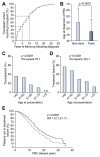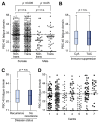The impact of liver transplantation on the phenotype of primary biliary cirrhosis patients in the UK-PBC cohort
- PMID: 23466308
- PMCID: PMC6976302
- DOI: 10.1016/j.jhep.2013.02.019
The impact of liver transplantation on the phenotype of primary biliary cirrhosis patients in the UK-PBC cohort
Abstract
Background & aims: Liver transplantation improves survival in end-stage primary biliary cirrhosis (PBC), but the benefit for systemic symptoms including fatigue is less clear. The aim of this study was to utilise the comprehensive UK-PBC Research Cohort, including 380 post-transplant patients and 2300 non-transplanted patients, to answer key questions regarding transplantation for PBC.
Methods: Cross-sectional study of post-transplant PBC patients and case-matched non-transplanted patients. Detailed clinical information was collected, together with patient systemic symptom impact data using validated assessment tools.
Results: Over 25% of patients in the transplant cohort were grafted within 2 years of PBC diagnosis suggesting advanced disease at presentation. Transplanted patients were significantly younger at presentation than non-transplanted (mean 7 years) and >35% of all patients in the UK-PBC cohort who presented under 50 years had already undergone liver transplantation at the study censor point (>50% were treatment failures (post-transplant or unresponsive to UDCA)). Systemic symptom severity (fatigue and cognitive symptoms) was identical in female post-transplant patients and matched non-transplanted controls and unrelated to disease recurrence or immunosuppression type. In males, symptoms were worse in transplanted than in non-transplanted patients.
Conclusions: Age at presentation is a major risk factor for progression to transplant (as well as UDCA non-response) in PBC. Although both confirmatory longitudinal studies, and studies utilising objective as well as subjective measures of function, are needed if we are to address the question definitively, we found no evidence of improved systemic symptoms after liver transplantation in PBC and patients should be advised accordingly. Consideration needs to be given to enhancing rehabilitation approaches to improve function and life quality after liver transplant for PBC.
Copyright © 2013. Published by Elsevier B.V.
Conflict of interest statement
The authors who have taken part in this study declared that they do not have anything to disclose regarding funding or conflict of interest with respect to this manuscript.
Figures




References
-
- Liermann Garcia RF, Evangelista Garcia C, McMaster P, Neuberger J. Transplantation for primary biliary cirrhosis: retrospective analysis of 400 patients in a single center. Hepatology. 2001;33:22–27. - PubMed
-
- Jacob DA, Neumann UP, Bahra M, Langrehr JM, Neuhaus P. Liver transplantation for primary biliary cirrhosis: retrospective analysis of results at a single center. Dtsch Med Wochenschr. 2006;131:2327–2332. - PubMed
-
- Tinmouth J, Tomlinson G, Heathcote EJ, Lilly L. Benefit of transplantation in primary biliary cirrhosis between 1985–1997. Transplantation. 2002;73:224–227. - PubMed
-
- Silveira MG, Talwalkar JA, Lindor KD, Wiesner RH. Recurrent primary biliary cirrhosis after liver transplantation. Am J Transplant. 2010;10:720–726. - PubMed
-
- Longworth L, Young T, Buxton MJ, Ratcliffe J, Neuberger J, Burroughs A, et al. Midterm cost-effectiveness of the liver transplantation program of England and Wales for three disease groups. Liver Transpl. 2003;9:1295–1307. - PubMed
Publication types
MeSH terms
Grants and funding
LinkOut - more resources
Full Text Sources
Other Literature Sources
Medical

